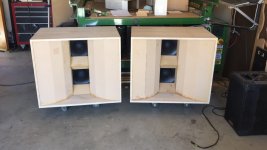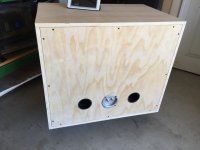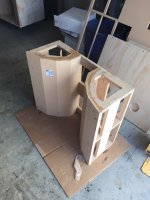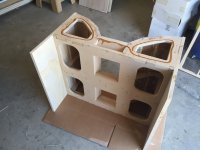Until you fill in the low end with (horn loaded) woofers 😉To be honest the horn sounds best with no XO.
Trying to nerd out this linear true peak thing While retaining the great summing of the 200hz xo point. I probably don't need it at 115db but I'll investigate what that may look like non the less. Having true linear peak ability isn't something that one can hear easily, I'd imagine. You'd have to be able to measure it.
Its not "that" choppy is it? +/-3db.....should be able to be fixed with eq and the summation of the mid woofer....
The harmonic peaks of the upper midrange is definitely from something non driver/horn related so I just ignore it.
Pretty much everything I can get out of the horn come across as much less "room" hence my attempt to maximize this attribute.
Hello Camplo
You ever hear of analysis paralysis?? If I were you I would be bolting on your driver to the horn and figuring out the center of gravity of your horns and driver and building a sled you can move back and forth and easily adjust any tilt as required. I would also limit the PEQ points to a minimum. You can think this stuff out to the cows come how but sooner or latter you have to bite the bullet and execute your design.
Rob 🙂
You probably have nothing to worry about at 10% distortion levels.Yes, the mic is at its limit.
How to use measurements to reliably indicate the compression drivers suspension limits?
Will the Oscilloscope give tell???
Should I say that 10% 2nd order distortion can safely be called Within Xmax???
The oscilloscope could tell you something, but you'd need to learn how to interpret what it can tell you.
I've mentioned using the CEA-2010 test many times already, it will make the low frequency limits of your horn/driver obvious, not only in the measurements, but audibly.
I'd suggest first working with your 15" to get the procedure down, then progress to the AXI-2050.
The horn should be angled down to point it's center axis at the test mic, so the (beamy) upper harmonics read correctly.
Grass will attenuate the upper harmonics a bit, placing plywood or other smooth hard surface in the two meters of ground between the mouth and mic would minimize that slight reduction.
https://brentbutterworth.com/cta-2010-manual
Art
Looking at matching bass (horn) solutions, there are many options, but few candidates for a true 2 way.
I believe Camplo has already been working on a PPSL-like solution, which should be good up to about 300 Hz.

Personally I like this one much better - especially in MMTMM configuration 🙂
The low-end extension is unfortunately limited to 70 Hz, which is of course perfect for midbass.


Considering portability, I would choose a modular solution myself.
A 4x15 cab with Tractrix mouthpieces (like the Klangfilm Euronor) could be a combination providing extension to below 40 Hz, a handful dB's of gain and directivity to match Camplo's mid/high horn, which can then be mounted coaxially in the horn mouth.
Alternatively, the same 4x15 cab can be used separately with the horn on top, or... you split the cab into 2 (2x 2x15), which can then also be used in MTM configuration.
I believe Camplo has already been working on a PPSL-like solution, which should be good up to about 300 Hz.
Personally I like this one much better - especially in MMTMM configuration 🙂
The low-end extension is unfortunately limited to 70 Hz, which is of course perfect for midbass.
Considering portability, I would choose a modular solution myself.
A 4x15 cab with Tractrix mouthpieces (like the Klangfilm Euronor) could be a combination providing extension to below 40 Hz, a handful dB's of gain and directivity to match Camplo's mid/high horn, which can then be mounted coaxially in the horn mouth.
Alternatively, the same 4x15 cab can be used separately with the horn on top, or... you split the cab into 2 (2x 2x15), which can then also be used in MTM configuration.
As Robh3606 rightly pointed out elsewhere, YT videos are generally unsuitable for providing a realistic impression of a loudspeaker system in a particular room. This video is therefore only illustrative of a rather large mid horn (which in this case is loaded by 2!! WE 555 substitutes) with direct radiating low section.
At this point why not a waveguide???Until you fill in the low end with (horn loaded) woofers 😉
Well what the heck! Where did I get the notion? Is 7-10% thd expectation at xmax strictly a dynamic driver type rule of thumb or is it not even consistently true? The thresholds of the CEA2010 burst are based around distortion values once again. This seems like a good way to set dynamic limits for a driver but not for finding xmax or xlim. Am I correct?You probably have nothing to worry about at 10% distortion levels.
Semantically because a "horn" has a primary function of increasing output.At this point why not a waveguide???
The woofer isnt really needing more output at this pointSemantically because a "horn" has a primary function of increasing output.
No, it doesn't need it, but I bet a horn loaded woofer will match the overall signature of your e-Trak horns much better. Especially as you've perceived the (positive) effects of horn loading down to the low midrange.
This 50 Hz mid bass horn is theoretically sub-optimal, because it's too short and the mouth is undersized. In addition, it is crossed 1st order at 250 Hz 🤔

Despite this, the system has received numerous positive reviews and the bass reproduction is sufficient for most owners (about 40 Hz in room).
What if you'd enlarge this horn by 25-50%?
This 50 Hz mid bass horn is theoretically sub-optimal, because it's too short and the mouth is undersized. In addition, it is crossed 1st order at 250 Hz 🤔
Despite this, the system has received numerous positive reviews and the bass reproduction is sufficient for most owners (about 40 Hz in room).
What if you'd enlarge this horn by 25-50%?
Last edited:
The CEA-2010 “pass” limits are a metric for comparing usable output based on objectionable distortion components, not for finding mechanical Xmax or Xlim measurements.Is 7-10% thd expectation at xmax strictly a dynamic driver type rule of thumb or is it not even consistently true? The thresholds of the CEA2010 burst are based around distortion values once again. This seems like a good way to set dynamic limits for a driver but not for finding xmax or xlim. Am I correct?
The distortion generated when a driver reaches Xlim will likely be above the CEA-2010 “pass” limits, or the more stringent CEA-2010A thresholds of -25 dB for the 4th and 5th harmonics, -35 dB for the 6th, 7th and 8th harmonics, and -45 dB for 9th and higher harmonics.
The AES2-1984 (r2003) defines Xmax for Low Frequency drivers as:
“Voice-coil peak displacement at which the “linearity” of the motor deviates by 10%, Xmax. Linearity may be measured by percent distortion of the input current or by percent deviation of displacement versus input current. Manufacturer shall state method used. The measurement shall be made in free air at Fs.”
Few manufacturers appear to use that definition, most derive Xmax as a linear mathematical value derived from various calculations based on voice coil vs gap height. Regardless of Xmax derivation, the distortion produced in free air at Fs won’t inform what distortion products occur at other frequencies and loading due to cabinet design.
If listed, a high frequency driver’s “Xmax” is probably the diaphragm to phase plug spacing, equivalent to Xlim, Xmech, Xdamage in a loudspeaker. Unlike a loudspeaker, the HF driver motor may be linear over the diaphragm’s entire range of excursion.
Art
At this point why not a waveguide???
Although a waveguide is not comparable to a real (mid) bass horn, it should offer some advantages over direct radiation (directivity, slight increase in efficiency).
JWC has designed an 1/4 space Tractrix successor to his 70Hz Tractrix midbass horn.
It is a dual 12" design that already goes down to 40 Hz in the ported version.
A dual 15" version should improve things further.
I would go for the ported version, but closed may be preferable if additional subs are used.
Front ported:
Attachments
Last edited:
The CEA-2010 “pass” limits are a metric for comparing usable output based on objectionable distortion components, not for finding mechanical Xmax or Xlim measurements.
The distortion generated when a driver reaches Xlim will likely be above the CEA-2010 “pass” limits, or the more stringent CEA-2010A thresholds of -25 dB for the 4th and 5th harmonics, -35 dB for the 6th, 7th and 8th harmonics, and -45 dB for 9th and higher harmonics.
CEA-2010A Traditional
(1M peak) (2M RMS)
40-63 Hz average 135.5 dB 126.5 dB
63 Hz 135.2 dB 126.2 dB
50 Hz 136.0 dB 127.0 dB
40 Hz 135.4 dB 126.4 dB
20-31.5 Hz average 130.5 dB 121.5 dB
31.5 Hz 133.6 dB 124.6 dB
25 Hz 131.4 dB 122.4 dB
20 Hz 123.7 dB 114.7 dB
200hz won, mainly because it seems the woofer involves the room more but 200hz seems to be that particular point in the spectrum that is the veil to localization in this room, for the midwoofer... There seems to be a transition at 200hz to where as if I move the point up or lessen the slope, theres, like, a veil lifted off of the midwoofer saying.....here I am, where as a steeper filter at 200hz on the mid-woofer disappears within the presence of the horn.I'd compare 200, 250 and 300 Hz (and probably settle for 250 Hz).
I will have to take this with a grain salt just incase all these ideas go out the window once in a more permanent position. This is just what I perceive in this present case.
Please don't be mad at me lol! Soooo in the nearfield whats going on? My guess is that nearfield suggest, being within the influence of heavy direct energy and if I use the inverse square law I will be exercising conservative views, by using 12" measurements that are within nearfield?The inverse distance (inverse square) law applies in the far field, in the near field and inside the horn it does not apply.
Using the Hulk movie as a template of potential true peak dynamic slope combined with the ideas of equal loudness.... it seems I'd only need ~110db at 1meter at 200hz...with at least a 200hz 2nd order XO I believe this is possible, in contingency with the above question....Also consider that 200hz will be another -3db in use of the XO taking even more load off.
So because I know that I don't know....I will go outside, voice, and check at 1m.
I moved the microphone over about 17" horizontal and the ripple did not "move"...Trying to equalize diffractive ripple is another fools errand because when you move your mic the ripple moves too.
I think I am all set for a 200hz 12db or 48dbt XO with regards of headroom... I believe I only need about 110-108db capability for headroom, at 200hz and I have that and then some I think.... Heres another outside measurement at 1m with voicing and 200hz 48db bessel. Not much, changes at, 200hz, between 48db and 12db slope, so either seem to fly. Below is 48db bessel at 200hz.
I don't know why I perceive this to be such a chore ....call me lazy... and then after I get everything back inside I remember that I did not take any off axis measurements...oommggggggg.
I have no idea what measurements you are comparing but the diffractive ripple in a measurement has to move if the distances involved are changed.I moved the microphone over about 17" horizontal and the ripple did not "move"...
Most likely what I am describing is not the same thing you are.
Camplo, label your charts, maybe I could then tell what the traces are. In the above, the response is quite different in the frequency extremes, if they were measured in the far field, they would be nearly identical, if they were both on-axis.Please don't be mad at me lol! Soooo in the nearfield whats going on? My guess is that nearfield suggest, being within the influence of heavy direct energy and if I use the inverse square law I will be exercising conservative views, by using 12" measurements that are within nearfield?
Below is 48db bessel at 200hz.
View attachment 1069462
I'll get back to you on that...supposed to rain soon. But yes...Post your two frequency response measurements at different angles and I'll see if I can.
I pretty much disregarded the 12" measurement and you inspired me to take the horn back outside and take 1meter measurements... Outside, I voiced the speaker and then I used the CEA2010 tone burst to test frequencies in the cross band for distortion, -4.5db on the gain sounded about right to me, as in, I shouldn't go higher this sounds distorted enough, then I ran a sweep as you can see in the last measurement.Camplo, label your charts, maybe I could then tell what the traces are. In the above, the response is quite different in the frequency extremes, if they were measured in the far field, they would be nearly identical, if they were both on-axis.
is there some other information you wanted? The horn is on my deck, facing the sky.outside measurement at 1m with voicing and 200hz 48db bessel.
Not trying to ruin the measurement party, but the outcome won't be fundamentally different from what I predicted based on the measurement data of the eTrak 300 by K+T. The horn is a physically fixed item and the limits of the Axi 2050 are also known.
The last plot roughly reaffirms these predictions: 200 Hz = lowest limit, 300 Hz = reasonable lower limit.
You could measure until hell freezes over, but you only change the observation points and/or the conditions, obviously not the physics of the DUT.
The last plot roughly reaffirms these predictions: 200 Hz = lowest limit, 300 Hz = reasonable lower limit.
You could measure until hell freezes over, but you only change the observation points and/or the conditions, obviously not the physics of the DUT.
Last edited:
- Home
- Loudspeakers
- Multi-Way
- Is it possible to cover the whole spectrum, high SPL, low distortion with a 2-way?



